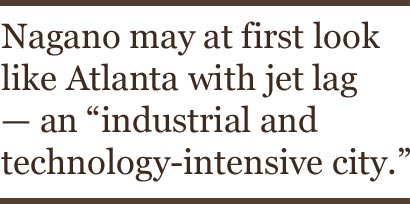For many of us, Japan has come to mean crowded trains, high-tech gadgets, efficient systems, cool reserve–a neon blur, in the imagination, of pencil-thin high-rises in which traders in dark suits mutter into cell phones. Or, if not the hard realism of Tokyo’s office blocks, then the gossamer romance of Kyoto’s teahouses, all exquisite restraint and antique silence. Though both these sides are suddenly in evidence in Olympic Nagano, for most of its life the city and the village venues all around it have offered a down-home, uncrowded, friendly Japan where some of the hard hats along Kencho-dori (Prefectural Office Street) are women and are wearing lipstick. The “Games from the Heart” the organizers promise are Games from the Heartland of a slow-paced, half-forgotten countryside that could almost be called Japan’s New England.
 To many Americans who’ve never before set foot in Japan, Nagano may at first look like Atlanta with jet lag–an “industrial and technology-intensive city,” as its brochures boast, larger than Newark, N.J., and lined along its broad boulevards with a cacophony of gas stations (called Apple), coffee shops (called Apple Grimm) and supermarkets (called Apple Land). There are seven Kentucky Fried Chicken parlors in Nagano, its literature attests, two Mister Donuts and a Denny’s.
To many Americans who’ve never before set foot in Japan, Nagano may at first look like Atlanta with jet lag–an “industrial and technology-intensive city,” as its brochures boast, larger than Newark, N.J., and lined along its broad boulevards with a cacophony of gas stations (called Apple), coffee shops (called Apple Grimm) and supermarkets (called Apple Land). There are seven Kentucky Fried Chicken parlors in Nagano, its literature attests, two Mister Donuts and a Denny’s.
But to Japanese city dwellers, used to even snazzier Vuitton and Panasonic pleasures, Nagano has the charm of a big city’s drawling country cousin, an apple-cheeked, wood-burning relative still known to eat raw horsemeat and pond snails and crickets. In a chestnut-filled village just 30 min. from central Nagano, a ruddy-faced high school boy gets off his bike to walk a visitor to his destination. An old woman at a country bus station counts out change with an abacus. The driver of a Highland Express cab (working 24-hr. shifts) is a robust woman with a basket of huge apples by her side. Nagano is a world of deep, ancestral sounds: the traditional melody of a potato seller audible downtown; the mournful strains of an enka ballad (often known as Japanese country-and-western) in a tiny noodle shop; the martial tunes that reverberate around the old battlefield near the Olympic Village.
Nagano, though only 120 miles northwest of Tokyo, has long been the provincial capital farthest in time from the center of Japan since unlike the cities on the outlying islands of Hokkaido and Okinawa, it has never had an airport. Even now, with a million Olympic visitors expected, the nearest airport to the Main Press Center consists of a modest, two-story box appointed with exactly four check-in counters and one baggage carousel, 75 min. away by (very occasional) bus. As your plane takes off from Matsumoto, the technicians all line up on the tarmac to wave goodbye.
Throughout its history, Nagano has been renowned as a temple town, home to one of Japan’s most ecumenical Buddhist centers, Zenkoji, a 40-structure complex set against the mountains. The cypress-roofed temple is the city’s center of gravity, marked on all the highway signs. Zenkoji announces itself with the shock of pounding drums, the smell of burning incense, the flutter of white-paper prayers. Somewhere inside its main hall is what is said to be the first Buddha image ever to arrive in Japan, so precious that only a replica is displayed once every seven years.
At dawn the grave walls shake with the sound of gongs and bells and clappers, and priests huddled in green robes, or all in black, gather around a brazier, drinking tea. A high priest in orange robes, followed by an attendant carrying a red umbrella, delivers blessings on the heads of rows of crouching petitioners. Underneath the main hall is the temple’s most charged metaphorical space, an underground passageway, black as the womb, in which the visitor, sightless, is invited to fumble through the cold and dark in search of a “Key to Paradise.”
A traditional magnet for Buddhist pilgrims, Zenkoji is approached past a long line of shops selling religious artifacts (though, this being Japan, they also offer pink bunnies and nudie telephone cards). Sidewalks brim with tables full of dried apricots and pumpkin seeds and sachets of apple tea. For all its modern accessories, Nagano remains a farmers’ town sought out for its pickles, its horseradishes and its homemade buckwheat noodles. Next to the feminine grace notes of a Kyoto, say, the northern city feels a decidedly masculine place. Its colors are brown and black, its aesthetic one of straw and stone. On its southern edge is Matsushiro, a castle town of old samurai houses and the remains of a military academy; to the north is Togakushi, a sacred, templed mountain favored by ascetics and home to a ninja museum.

Explore Related Articles

